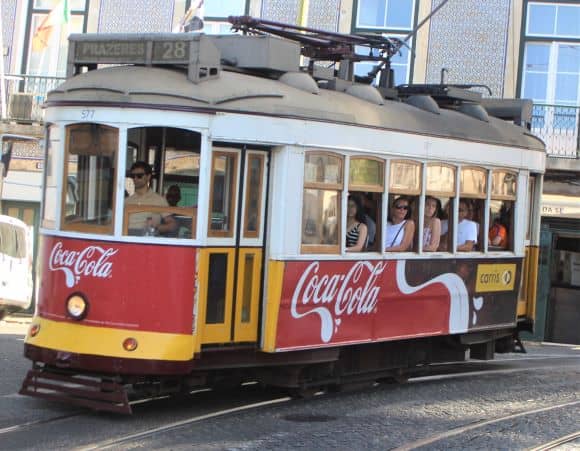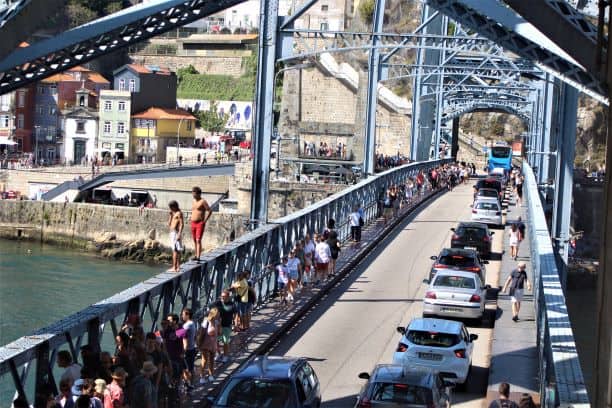Portugal has an efficient transportation network of light rail, bus, metro, and ferry. But, their high speed train system lags behind the rest of Europe.
Public Transportation
Most cities in Portugal have public transportation to serve the community. The systems in Portugal’s biggest cities of Lisbon and Porto are world-class.
Lisbon
Portugal’s capital is known for its characteristic “Remodelado” trams. These charming carriages run through the narrow streets of Lisbon taking locals and tourists around the city. They haven’t been replaced because Lisbon’s streets are quite cramped and today’s wider coaches would be unable to navigate the tight passageways. Riding the #28 Tram is a highlight of any trip to Lisbon.

There is also a modern underground metro lacing together the city with 4 lines and 56 stations and an extensive bus network.
Three ferry terminals serve a half dozen destinations across the Tagus River. These are mostly for commuters, but tourists will enjoy the views as well.
Porto
Porto also has an extensive Metro light rail system with 7 lines that reaches the suburbs and airport. There is also a network of 3 tram lines, which, like Lisbon, have some charming carriages operating on them. Buses fill out the system. And, the Funicular dos Guindais will save you the steep climb from the river.
One of the highlights of a trip to Porto is traveling across the Dom Luís I Bridge, connecting Porto to Vila Nova de Gaia over the Douro River. A rail line runs on the upper section of the bridge, but there are pedestrian walkways on both the upper and lower levels.

Portugal train system
Most of Portugal is connected with train service. Some remote areas might only have a bus station of no public transport at all.
With massive investment, the entire infrastructure of Portugal has improved in recent decades.
This includes the rail service along the Atlantic Ocean from Porto through Lisbon and on to Faro in the southern region of the Algarve. This corridor is where most of the population of Portugal resides.
Today, the Alfa Pendular high speed service runs between Porto in the north to Faro in the south. Lisbon resides about halfway along the route. The trip from Porto to Lisbon is about 206 miles and takes about 3 hours. Continuing from Lisbon to Faro is an additional 200 miles or so and takes another 3 hours. That means that getting from Porto to Faro takes about 6 hours with a distance of almost 400 miles. Or, to put it another way, you’re traveling at an average speed of about 66 mph. That might seem pretty good when you compare it to the Amtrak trip from Los Angeles to San Francisco which is shorter (≈250 miles) and takes longer (9.5 hours).
But, when you compare this to other high speed rail trips around the world, it is quite pokey.
For instance, in France the TGV high speed train whisks you from Paris to Bordeaux (310 miles) in 2 hours and 15 minutes at an average speed of about 140 mph. And, on the Iberian Peninsula, you can get from Madrid to Barcelona (about 300 miles) in about 2.5 hours.
For real land-based speed, China has a train that travels at an average speed of almost 190 mph, making the trip from Beijing to Shanghai (a little over 800 miles) in about 4 hours and 15 minutes.
Japan is also known for their high speed bullet trains. A trip from Tokyo to Kyoto (about 320 miles) only takes 2 hours and 20 minutes and averages over 135 mph.
As you can see, Portugal has a way to go before it catches up with these speedy options.
The future of high speed rail in Portugal
The Portuguese government was looking to upgrade the high speed rail service through the country and into Spain when the economic crisis of 2008 stopped several projects in their tracks.
Recently, however, the project has been revived. In it, an upgrade, taking several years to complete, would cut travel time between Lisbon and Porto to just 75 minutes! That would make it the fastest high speed rail line in Europe and put it in the same ballpark as the Chinese trains.
In addition, another high speed line from Porto, running north through Braga and into the northern Spanish city of Vigo would be built. This proposed project would cut travel times from about 2.5 hours to 55 minutes.
Connecting Portugal to the rest of Europe
Portugal is on the far western edge of Europe. Getting there from the rest of the continent by bus or rail is time consuming and inconvenient.
There’s an overnight train from Madrid that takes 10 hours and covers about 300 miles. That’s about the same distance as Paris to Bordeaux which only takes 2 hours and 15 minutes on the TGV! Lisbon and Madrid aren’t backwaters; they’re two of the most popular capital cities in the world!
But, there is a plan, with heavy Eurozone investment, to complete a high speed link between Lisbon and Madrid that could make the journey in 2-3 hours.
Once the Lisbon to Madrid line is upgraded, and other lines are upgraded as well, it might be possible to get from Lisbon to Paris in 11 hours or less. That would cut the current travel time almost in half.
Train vs. Plane travel
Now, 11 hours might sound like a long to be on a train, but hear me out. Flying from Lisbon to Paris takes 2.5 hours. However, you have to add in the extra time at the airport. That’s an additional 2 hours at the departure airport and 1 hour at the destination airport (deplaning, getting luggage, getting ground transport).
Then, you’ve got to get to and from the airport. That’s at least a half hour to get to the Lisbon Airport. In Paris, it’s at least an hour from Charles de Gaulle Airport to downtown.
Of course, there’s travel time to and from the train station. Typically, however, train stations are much closer to the center of town and quicker to access.
Add it all up, and you’re up to 7 hours when traveling by plane. Add in the inevitable delays, be they flying or on the ground, and it could be 8 hours or more.
And, don’t forget the stress of flying.
Me? I’d much rather sit in a comfortable train seat and watch the countryside at 150 mph (or more).
Environmental considerations
The amount of carbon emitted varies by type of plane, distance flown, altitude and other factors. Likewise, trains can emit differing levels of carbon as well. For example, a train using electricity in a country where that power is derived from solar or wind sources would emit far less carbon than a train operating in a country where electricity is generated by coal-fired plants.
However, when you take all these factors into consideration, train travel inevitably comes out the winner winner with planes emitting up to 40 times more carbon per person per mile than train travel.
About the Author

Brent Petersen is the Editor-in-Chief of Destination Eat Drink. He currently resides in Setubal, Portugal. Brent has written the novel “Truffle Hunt” (Eckhartz Press) and the short story collection “That Bird.” He’s also written dozens of foodie travel guides to cities around the world on Destination Eat Drink, including in-depth eating and drinking guides to Lisbon, Porto, Sintra, Monsaraz, and Evora in Portugal. Brent’s podcast, also called Destination Eat Drink, is available on all major podcasting platforms and is distributed by the Radio Misfits Podcast Network.
